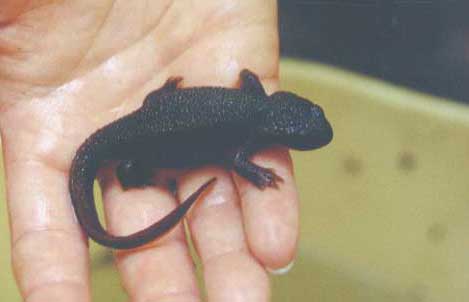
Rough-skinned newt or Pacific Coast Newt or Western Newt (Taricha granulosa)
General: Defensive toxin released if the newt is severely agitated.
Identification: Solid brown dorsal coloration with a bright orange belly. Body surface is roughened with small tubercles and is dry to the touch. Maybe 120 to180mm in length, with males having longer tails than females. Larvae are pond-type with blunt heads and single rows of yellowish dots along the sides. They transform in late summer grow about 50-70mm long.

Habits: Prefer open woods with lots of deadfall and litter, usually found near permanent ponds or swamps.
Feeding: Larvae eat small aquatic invertebrates, adults feed on soft-bodied invertebrates, and tadpoles.
Breeding: Breed in early spring in shallow ponds, bays, and swamps. Eggs are attached singly to aquatic plants. Larvae may take one or two seasons to transform.
References: Green, David M. and Campbell, R. Wayne. 1992. The Amphibians of British Columbia. Royal British Columbia Museum. Victoria, B.C.
© 2009 Veins of Life Watershed Society / All Rights Reserved / if you wish to use any info for commercial or non commercial usage you must obtain permissions from The Veins of Life Watershed Society